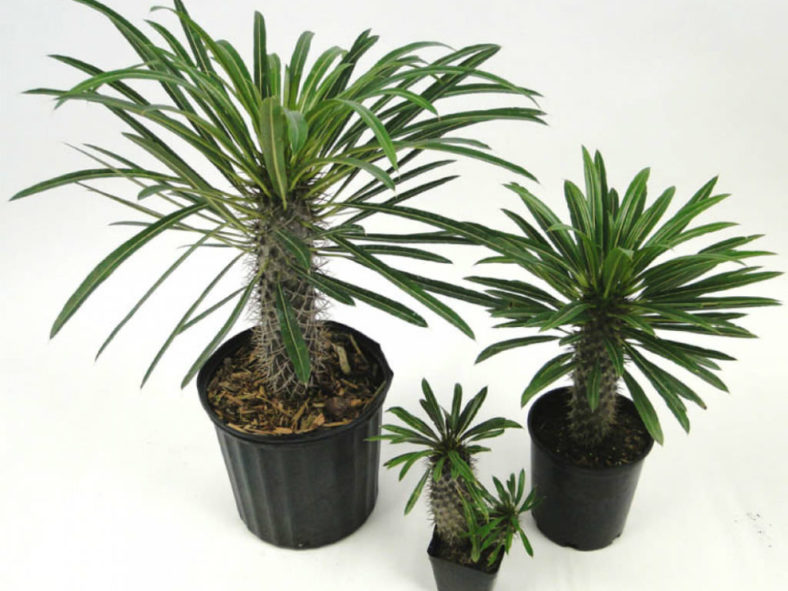Pachypodium is a genus of succulent plants that look like cacti but are different plants. The main difference is that the Pachypodiums have visible leaves. In some species, the leaves are even huge concerning the plant, for example, Pachypodium rutenbergianum and Pachypodium lamerei. This characteristic means that these plants use their leaves to quickly acquire their necessary water and carbon dioxide needs. So they receive their nutritional needs, especially during the rainy season, which may be suddenly and violently in the warm season. This is necessary for them as the growing season is quite short in their natural environment.
Pachypodiums have large fibrous roots that absorb moisture very quickly, as they need to take advantage of sudden (but very rare) good rains in their natural habitat. In contrast, most other succulent plants have much finer roots. Pachypodiums have a thick and shiny bark that makes it possible to reflect the intense sunlight and protect themselves from drying out during long periods of drought.
Growing Conditions and General Care
The three parameters, light, temperature, and watering, are closely linked. Therefore, you should not change one without the other two. It is, therefore, important to note that the balance of these three parameters determines the good or bad health of your plant.
All Pachypodiums, except perhaps Pachypodium succulentum and Pachypodium bispinosum from South Africa, need much light because they originally grow under full sun in tropical countries. Direct sunlight is not necessary, but the sunlight should not be shielded by natural (or artificial) view protection. A Pachypodium lacking light will wither, its branches will be weak and appear "lean," and the leaves will be too long and soft. Over time, the plant will be susceptible to disease and fungus and eventually die.

The temperature can be very high, as in Madagascar and South Africa habitats in the summer. However, the minimum temperature is much more important for growing Pachypodiums because it triggers the rest. For most Pachypodiums, the minimum temperature is about 55 °F (13 °C). However, it depends very much on the moisture of the soil. The drier the soil, the lower temperatures possible. Ideally, you should not fall below a minimum temperature of 59 °F (15 °C) during the rest period.
In the growth phase, the Pachypodiums require a lot of water. The fact is that the climatic environment drives them to store as much water as possible quickly. As the rainy season can be very short, the plant must quickly invest its reserves. For beginners, it is sometimes difficult to consider when and how much water you should give to Pachypodiums. It would be best if you did not treat them like cacti. A helpful rule is the soil not be completely dry to the soil during periods of active growth.
The dormancy or rest period of Pachypodiums is the most delicate moment to decide if you should water or not and how much. It is the time that beginners most misunderstand. It is different from other succulents, so the plant will not survive without irrigation until next spring. Although the plants are very hardy, you should consider that they need regular water to replenish their moisture reserves in the rest period.
Pests and Diseases
Fortunately, Pachypodiums are rarely attacked by insects, and fungi are scarce. It is always better to solve the problems that may occur mechanically (such as spraying water on the leaves when beetles are on) or to try biological and organic products. Most of the problems come from the treatment and cultivation, so it is important to first think before treating the plant with an aggressive product because the consequences for the plant could be very bad.
Source: seedsplants.com
Links
- Back to genus Pachypodium
- Succupedia: Browse succulents by Scientific Name, Common Name, Genus, Family, USDA Hardiness Zone, Origin, or cacti by Genus
